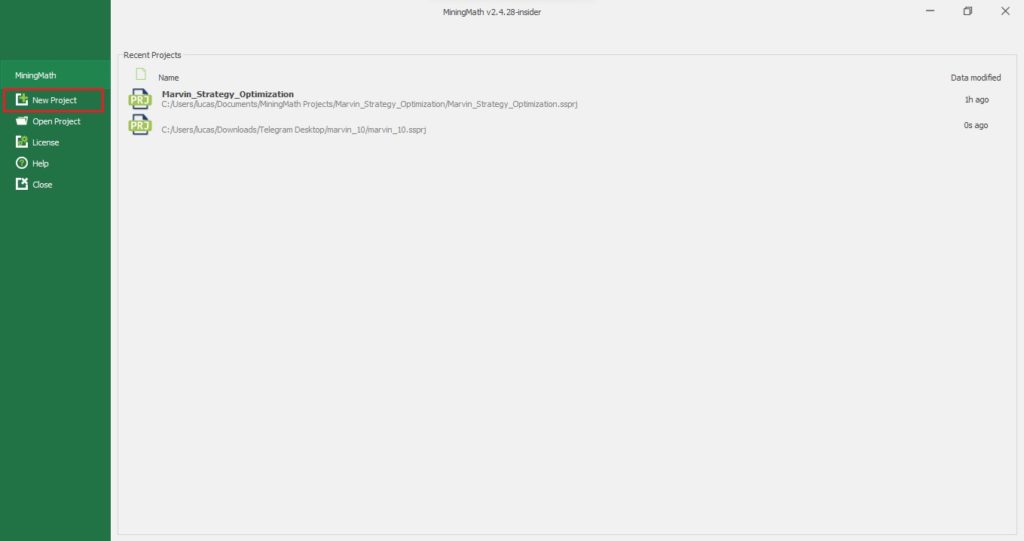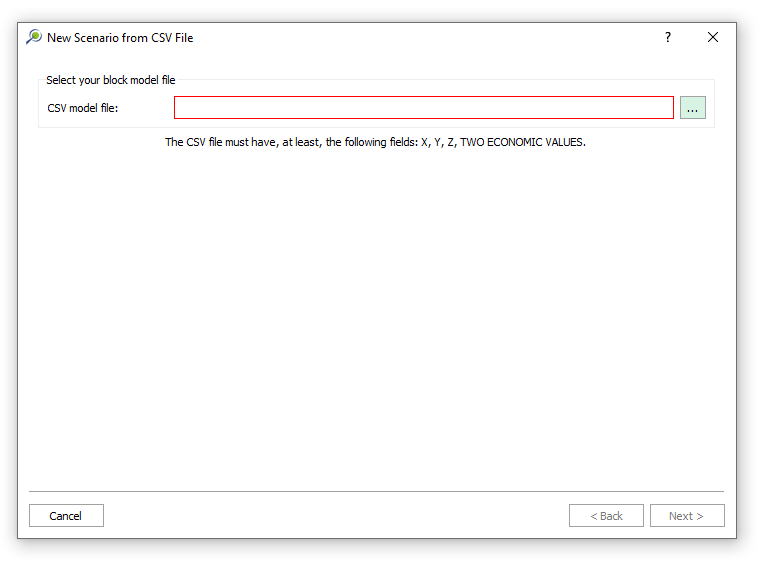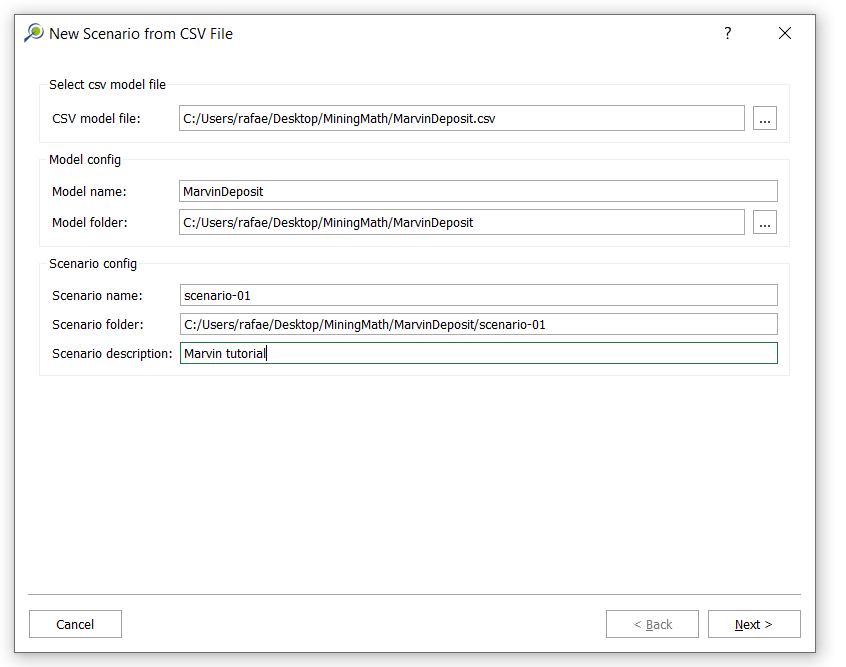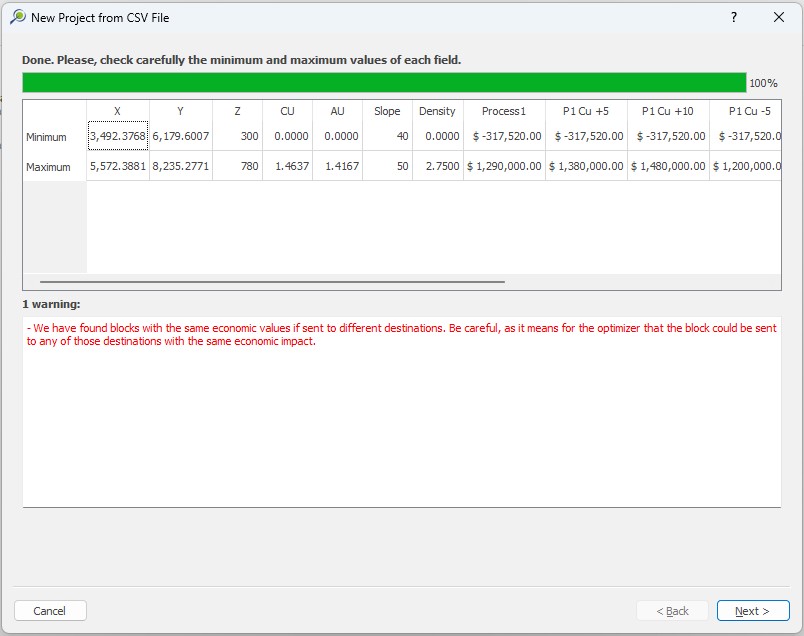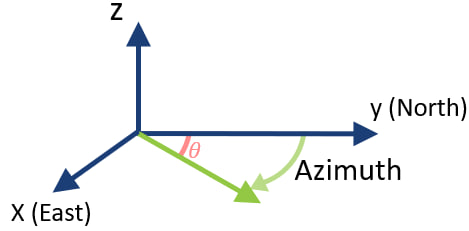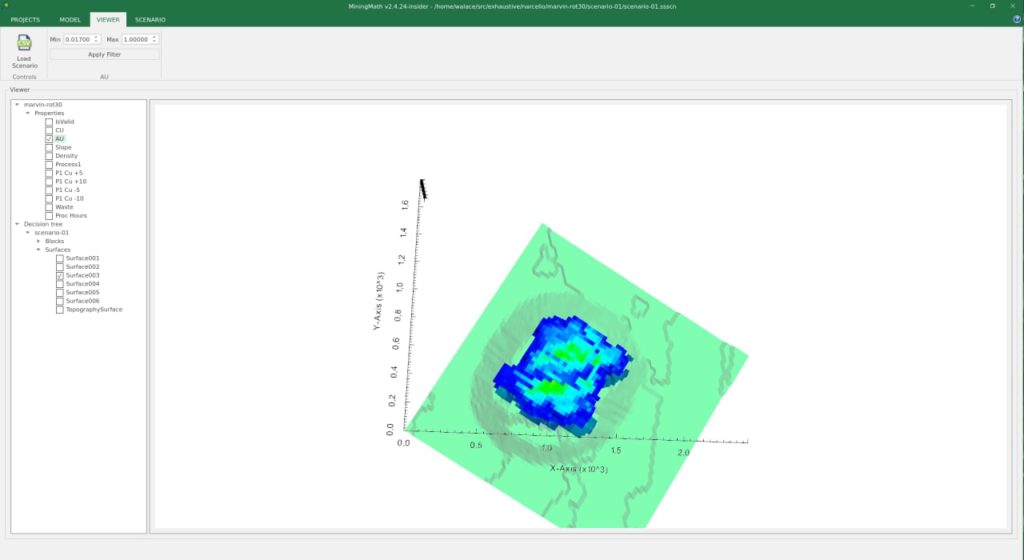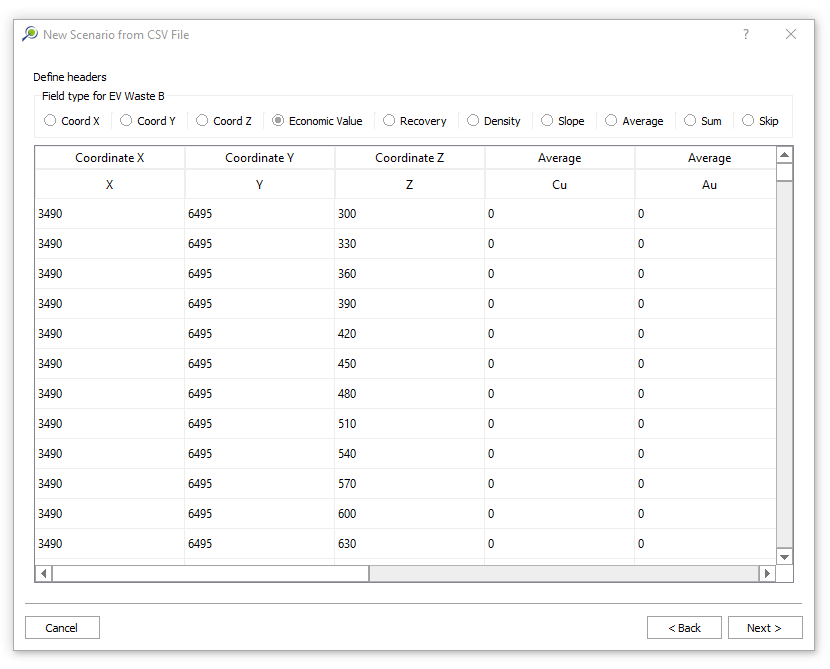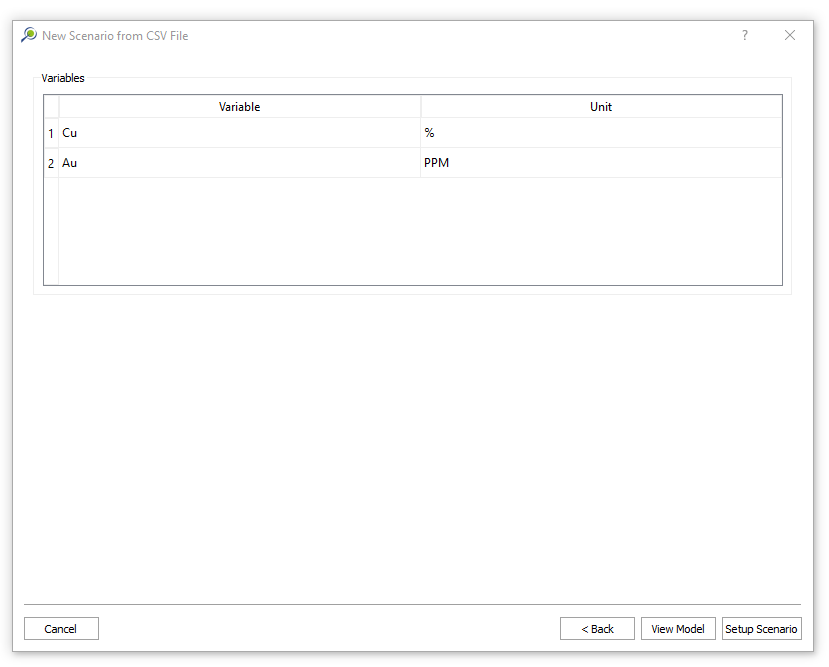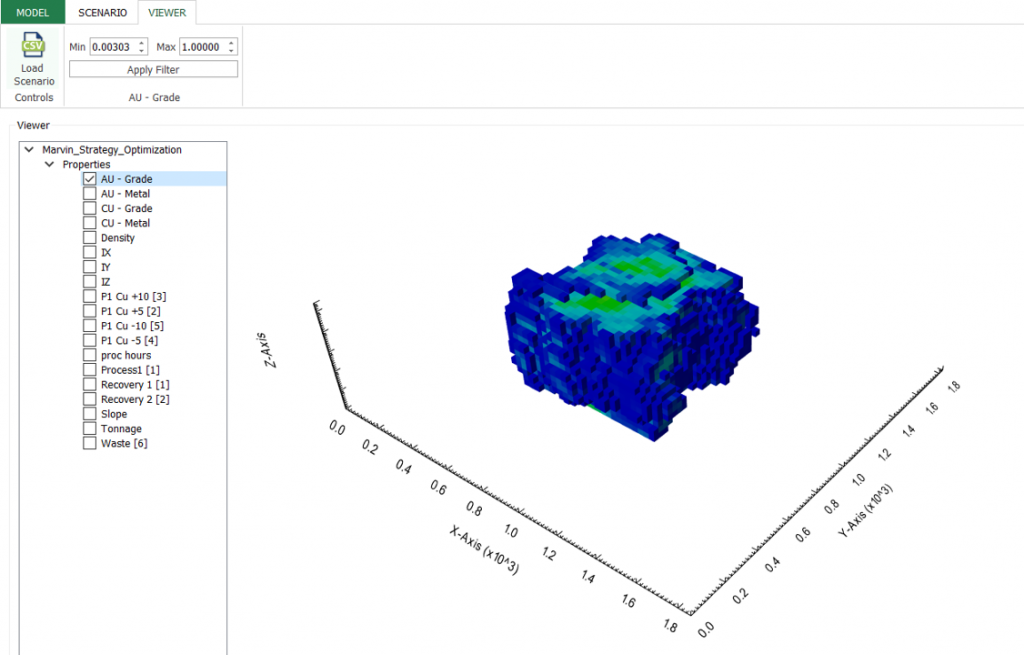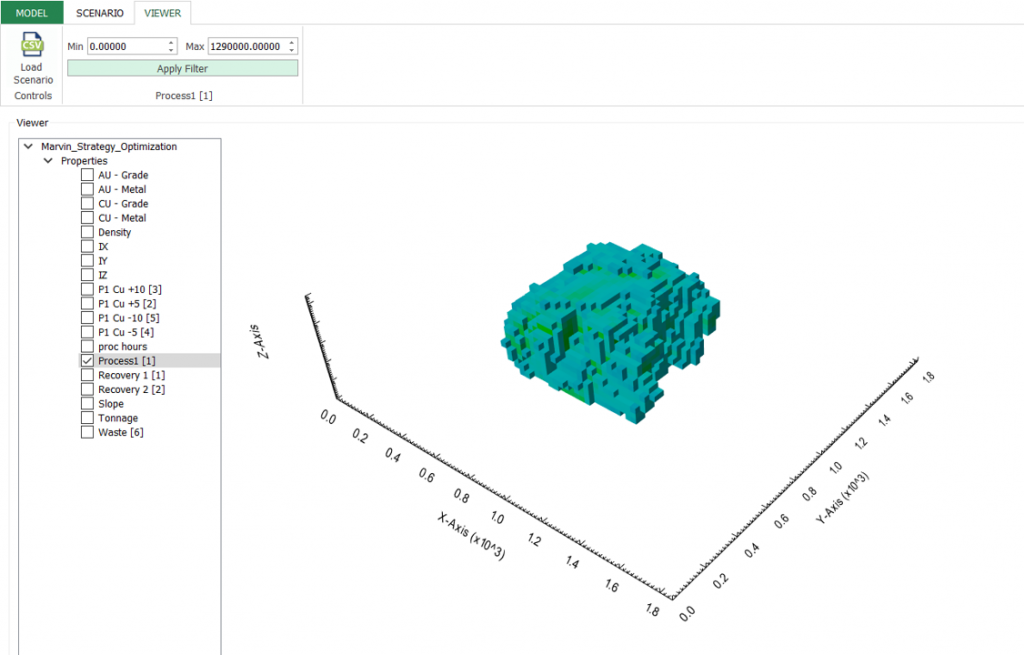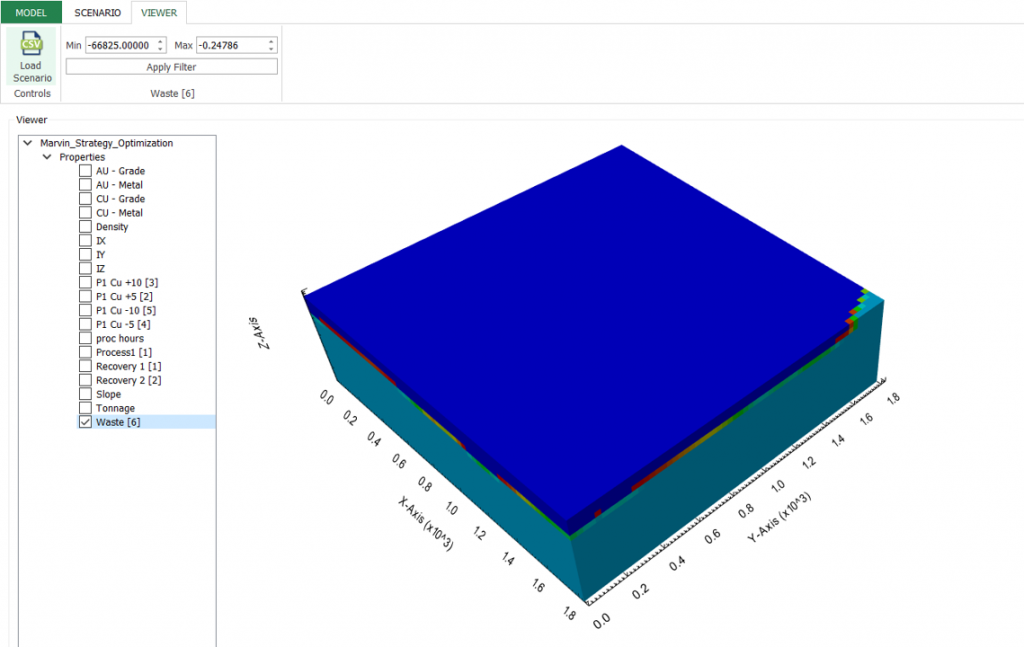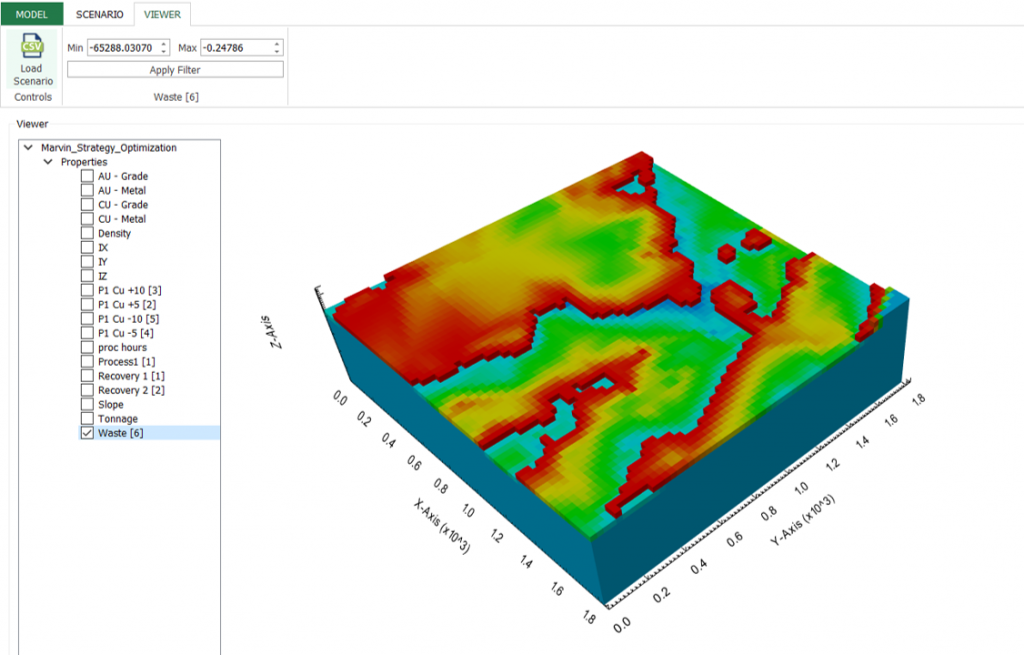Importing the Block Model
Highlights
Correct block model import is critical for integrating geological and economic data to support effective mine planning and optimization. MiningMath needs uniform block sizes and air blocks removal before import.
Project parameters
A series of project parameters will be requested in order to setup your project. This will be asked in a series of forms as detailed next.
Project naming
In the next window the Model Name must be entered.
Optionally, the destination folder (Model Folder) can be changed as well as the Scenario Name, and a Scenario Description can be added.
Imported fields and validation
Upon clicking Next, the following window will provide a statistical summary of information for the block model that will be imported. Check the parameters carefully, In particular economic values
NaN values
Columns imported must contain only numeric values. If a column includes non-numeric values, its minimum and maximum values will appear as “NaN” in the preview. Additionally, the system will only allow the column to be set as “other” or “skip.” Ensure your data is properly formatted to avoid this issue.
Geo-reference system, origin, dimension and rotation
Upon clicking Next, the CSV file will be imported into MiningMath, and show data related to the block model geo-reference system, that can be only coordinates. The next steps are to place the rotation degrees (Azimuth rotation), origin (accordingly with your mining package) and the block dimension. The number of blocks is automatically calculated after the origin and dimensions are provided as depicted below.
Rotated models
MiningMath supports the use of block models that have been rotated using an Azimuth rotation.
The amount of rotation degrees can be passed as depicted in below.
After importing, you can see the rotated model in the Viewer tab.
The detailed steps with mathematical formulations for the rotation procedure can be seen here.
Working with rotated and non-rotated models in multi-mine
To manage multiple pits (multi-mine) within a single project, with as a combination of a rotated pit and a non-rotated pit, follow these steps:
1. Unrotate the rotated model, converting it into a regular model.
2. Combine your models into a single block model.
3. Run your scenarios.
4. Rotate the results back.
Field type assignment
When Next is selected, the following form will appear, showing correlations between the imported CSV file header and the available field types in MiningMath.
You must associate each imported column to one of the options located just above the table, for instance: block coordinates X, Y, and Z to Coord. X, Y, and Z field types. For more details on how you can correlate each column, access this link. You can also keep the original data from your previous Mining Package, by using this approach.
If you do not already have an Economic Value function, when importing your block model, you will be directed to the Scenario tab. Then, click on the Function tab to calculate your Economic Value function in the internal calculator as explained here.
Notes
MiningMath has mandatory variables (columns) to be assigned to the proper Field Type:
1) Coordinates (X, Y, Z).
2) Average
Validating data screen might be overlooked, but it is very important to validate one's data based on minimums and maximums. Read more.
Each column imported should be assigned to the proper field type in order for MiningMath to treat each variable accordingly. Read more.
Typically, MiningMath recognizes some columns automatically when their headers are similar to the Field Type name. Otherwise, the MiningMath will automatically assign them to the Field Type sum.
To enable the Next button, the user needs to assign each one of the mandatory variables to their respective Field Type.
Evaluate your model
After filling all the required fields, the options View Model and Setup Scenario will be enabled. Before setting up your first scenario you can view it by clicking in the View model (example below).
This evaluation in the Viewer should help you answer questions such as:
- Where are the high grades distributed?
- Does the process economic values, above zero, match with the regions identified in the last question?
- How are waste economic values distributed? Are maximum and minimum values reasonable when you compare them with the process?
Possible issues
Invalid index error
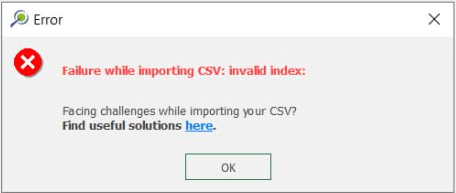
This is usually an error related to the origins. We recommend checking the origins from the previous mining package, otherwise, MiningMath’s results won’t match the actual coordinates.
You should be aware that MiningMath employs coordinates (X,Y,Z), where Z, representing elevation, starts from the bottom. However, some other mining software may start from the top.
Also check the minimum and maximum values for each coordinate (X, Y and Z) of your CSV file to confirm if they are all within the box of your block model. And always remember that the origin must be the (minX, minY, minZ) of this box, as shown here. Therefore, all the block centroid coordinates in the CSV must be greater (>) to the origin values.
The calculation of the origins is quite simple. Usually, when your CSV file has all blocks below the topography, just take the minimum value of each axis, indicated on the first import screen, and subtract half a block. This will give you the correct origin.
This error may also be related to other aspects such as incorrect spacing (coordinates that do not respect the block dimensions, considering the set of coordinates and the origin), and repeated coordinates, among others. Therefore, we also recommend reviewing the steps of formatting the block model and importing the block model to ensure there are no inaccuracies.
File access permissions
Read permission is required to import your CSV file, while write permission is necessary for SSMOD file. Ensure that the user or group has appropriate permissions in that folder. For more information on configuring file and folder permissions, please refer to the relevant section in the Windows documentation or contact your system administrator.
If you’re getting a “Cannot open file” error when trying to load your CSV into MiningMath, even after trying different locations and running as administrator, here are the main steps to troubleshoot it:
1. File Is Open Elsewhere
Make sure the file is not open in Excel or another program when you’re trying to load it.
2. File Format Check
MiningMath requires CSV files with UTF-8 encoding and correct structure. Let’s double-check a few things:
- .csv format only – make sure it’s not saved as
.xls,.xlsx, or.csv.txt. - No commas in headers or values unless they are part of the structure.
- Decimal separator should be dot
., not a comma,.
3. File Path Issues
- Avoid non-English characters or spaces in the file path or file name.
- Good:
C:\MiningMath\Projects\blockmodel.csv - Bad:
C:\Usuários\João\Área de Trabalho\meu_modelo.csv
- Good:
- Place it in a simple location like
C:\MiningMath\model.csv.
4. Windows Permissions
You’ve already tried launching as Administrator – that’s great. But if you’re on a corporate or school computer, IT restrictions could still block access. Try moving the file to:
C:\Users\Public\ And open from there.
5. Corrupt File or Wrong Encoding
Sometimes Excel saves the CSV in an incorrect encoding.
Here’s how to fix that:
- Open the file in Notepad.
- Go to Encoding > Select UTF-8.
- Save the file.
- Try loading it again.
Insufficient Memory
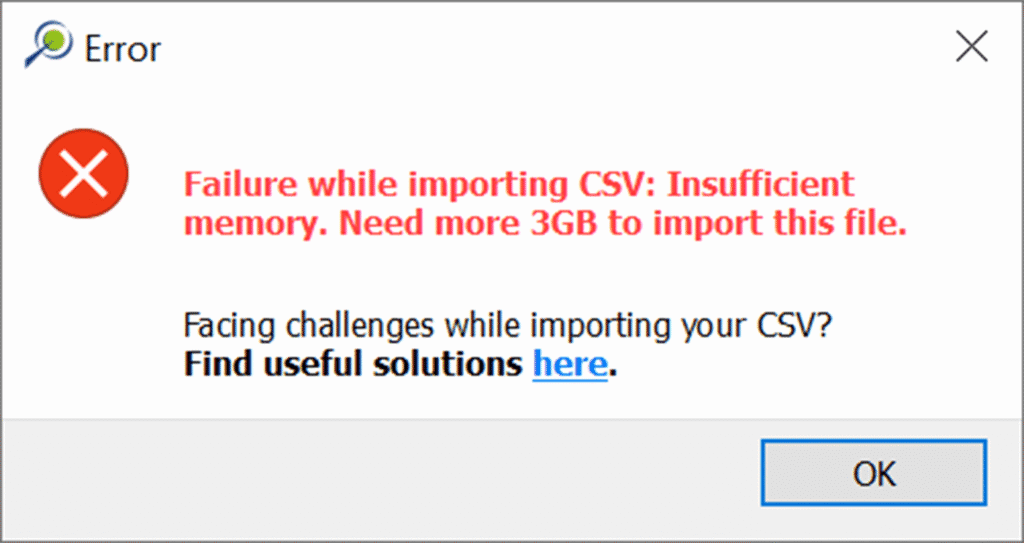
If you experience an insufficient memory warning or a sudden crash while using MiningMath, here are some steps to improve performance:
Upgrade Your RAM: if possible, increasing your RAM is the most effective way to enhance performance. The recommended specifications are listed in the “Recommended Hardware” section. Based on our experience with complex projects, 64 GB is sufficient for most cases.
Free Up Memory: close any unnecessary applications running in the background to free up RAM while using MiningMath.
Increase Windows Virtual Memory: you can allocate disk space to be used as additional RAM. For step-by-step instructions, follow this tutorial.
Reblock the Model: if memory issues persist, consider reblocking to reduce the model size. More details can be found here.
Decimal separator
MiningMath does not recognize CSV’s using semicolon (;) as a decimal separator. To change it on Windows, go to:
'Control Panel' > 'Clock, Language, and Region' > 'Region' > 'Change date, time, or number formats' > 'Additional Settings'
Next, change the List Separator to the comma sign (,). Press OK and OK. Finally, you will need to change the separator on the CSV. On Excel, you will need to open it, convert text to columns, and then save it again.


